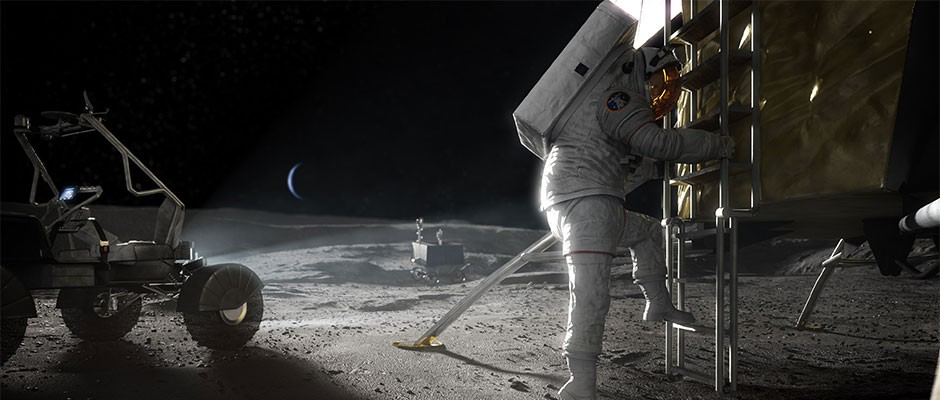Oct 12 2020
Scientists are set to build an advanced optical communications station in Western Australia. The new station will be able to receive high-speed data transmissions from space.
 An artist’s impression of Artemis astronauts on the Moon. Image Credit: NASA.
An artist’s impression of Artemis astronauts on the Moon. Image Credit: NASA.
The state-of-the-art communications ground station will be designed to receive data from spacecraft anywhere between the surface of the Moon and the low-Earth orbit. The station is also capable of supporting revolutionary space projects, such as NASA’s Artemis mission to land the next man and the first-ever woman on the Moon by 2024.
The optical communications ground station will be deployed at The University of Western Australia (UWA).
The station is a joint initiative of UWA’s Astrophotonics Group—part of the International Centre for Radio Astronomy Research (ICRAR)—and also the ARC Centre of Excellence for Engineered Quantum Systems (EQUS) and Goonhilly Earth Station, the UK industry partner.
According to Dr Sascha Schediwy, leader of the Astrophotonics Group from ICRAR-UWA, optical communications is an emerging technology that is anticipated to transform data transfer from space.
Most current space communications rely on radio waves—it’s the same technology that brought us the voice of Neil Armstrong when the Apollo 11 mission landed on the Moon in 1969. Free-space optical laser communications have several advantages over radio, including significantly faster data rates and hack-proof data transfer.
Dr Sascha Schediwy, Astrophotonics Group Leader, ICRAR-UWA
Dr Schediwy continued, “It’s the next-generation of space communications, and it’s likely to be how we’ll see high definition footage of the first woman to walk on the Moon.”
The optical ground station was recently launched to correspond with the International Astronautical Congress—the world’s leading global space event. The new station will be part of a bigger Australasian optical ground station network, headed by the Australian National University, and with associates in New Zealand and South Australia.
According to Andrew White, Professor and Director of EQUS, the new project, which may be the first “on-sky” optical communications ground station to be installed in the Southern Hemisphere, is a major example of fundamental studies delivering real-world results.
EQUS delivers major impacts by encouraging and enabling our people to translate their research into tangible technologies and applications. We are building a culture of innovation, translation and commercialisation amongst quantum science researchers in Australia.
Andrew White, Professor and Director, ARC Centre of Excellence for Engineered Quantum Systems
In addition to space communications, the optical ground station may also be used for a variety of applications spanning from innovative fundamental physics to precision earth science and resource geophysics.
The optical ground station would play a key role in the advancement of the “quantum internet”—that is, secure data transmission across the world using quantum-key distribution through optical links to quantum satellites, Professor White added.
He further stated that the new station will serve as an example of ground-breaking science collaborating with progressive businesses and providing impacts for both.
The optical ground station will utilize a 0.7-m observatory-grade optical telescope donated by Perth local Colin Eldridge to ICRAR. It will be integrated with sophisticated atmospheric-noise suppression technology designed at UWA.
The optical ground station will be linked to Goonhilly Earth Station’s supercomputer data center based in Cornwall through a high-speed fiber.
Goonhilly Earth Station manages data traffic and supports safe communications links for leading satellite operators across the world, such as Eutelsat, Intelsat, and SES Satellites. The firm is also a partner in the Lunar Pathfinder Mission of the European Space Agency. This mission is set for launch in 2022.
Ian Jones, chief executive from Goonhilly Earth Station, stated that he was happy to team up with ICRAR and EQUS to launch an advanced optical communications ground station in Western Australia.
We’ve been at the forefront of satellite communications since the start of the space age, and this is driving it into the next generation of systems and technologies to support the enormous data volumes emanating from space missions. This data arises from science and other missions and, in the future, will come from Lunar and Mars missions that involve remote operations, robotics and AI.
Ian Jones, Chief Executive, Goonhilly Earth Station
Jones continued, “We’re proud to be joint trailblazers in the practical implementation of coherent optical communications.”
Dr Schediwy added that the optical ground station in Western Australia will help demonstrate the space communications capacity of Australia.
“This will cement Australia’s position as a leader in optical data transmission, and position the nation to tap into the multi-billion-dollar space communications market,” Dr Schediwy concluded.
The new station, worth $535,000, is anticipated to be “on-sky” in early 2021 and will open for business later on the same year.